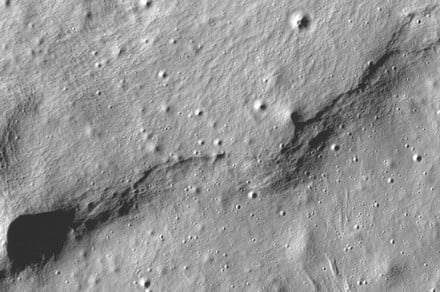New surface features of the Moon have been discovered in a region called Mare Frigoris, outlined here in teal. NASA
New research suggests the Moon may actually be shrinking. NASA scientists have used data from their Lunar Reconnaissance Orbiter Camera (LROC) to look at “wrinkles” in the surface of the Moon which are formed as it loses heat and shrinks in size.
The Mare Frigoris, also known as the Cold Sea, is a region near the Moon’s north pole which scientists have been studying in depth. They completed a survey of more than 12,000 images showing the hills and trenches on the Moon’s surface, which are noteworthy for being located within a basin. These wrinkles have been found in other lunar regions like the highlands, but scientists were surprised to find them in the basin as it was assumed that basins were dead and inactive.
This image of lobate scarps — a kind of curved hill — was taken near a region of the Moon called Mare Frigoris by NASA’s Lunar Reconnaissance Orbiter (LRO). NASA
Previously it was thought that geological activity in the basins would have ended 1.2 billion years ago. But in fact, the data shows that some of the wrinkles were formed as recently as 40 million years ago, which is fairly recent in geological terms. The wrinkles form through a process called tectonics, which here on Earth is driven by the movement of pieces of the Earth’s crust. But on the Moon, the process is driven by the loss of heat over time which causes the interior to shrink.
“The Moon is still quaking and shaking from its own internal processes,” Nathan Williams, a post-doctoral researcher at NASA’s Jet Propulsion Laboratory, explained in a statement. “It’s been losing heat over billions of years, shrinking and becoming denser.”
These graben — a kind of trench that is formed as a surface expands — were imaged near a region of the Moon called Mare Frigoris by NASA’s Lunar Reconnaissance Orbiter (LRO). NASA
The longest ridge identified stretches for 250 miles, and the tallest reaches up to 1,000 feet above the surface. The same tectonic processes also give rise to low hills called lobate scarps and shallow trenches known as graben. These features can be dated by looking at impact craters, as the longer a piece of terrain has been on the surface, the more meteors will have struck it, and the more debris will have fallen nearby.
In the Moon’s lifespan since it was formed four billion years ago, it has shrunk considerably. “Based on the size of the scarps, we estimate the distance between the moon’s center and its surface shrank by about 300 feet,” Dr. Thomas Watters, researcher at the Center for Earth and Planetary Studies, said in a statement.
Editors’ Recommendations
- See the impact site where the Beresheet spacecraft crashed into the moon
- NASA scientists want to send a cave-diving rover to the moon
- Tiny amounts of water bounce along the surface of the Moon
- Beresheet crash caused by manual command, but reflector device may have survived
- A lunar time capsule: 50-year-old moon rock samples to be opened for study

